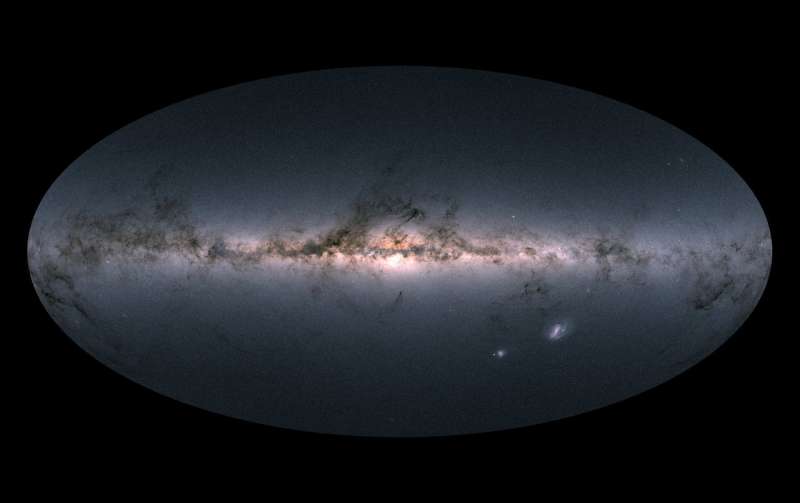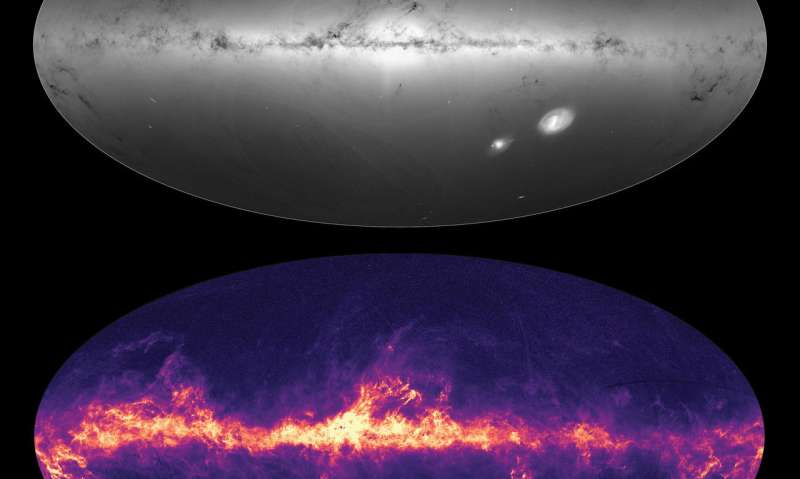Gaia creates richest star map of our Galaxy—and beyond

ESA's Gaia mission has produced the richest star catalogue to date, including high-precision measurements of nearly 1.7 billion stars and revealing previously unseen details of our home Galaxy.
A multitude of discoveries are on the horizon after this much awaited release, which is based on 22 months of charting the sky. The new data includes positions, distance indicators and motions of more than one billion stars, along with high-precision measurements of asteroids within our Solar System and stars beyond our own Milky Way Galaxy.
Preliminary analysis of this phenomenal data reveals fine details about the make-up of the Milky Way's stellar population and about how stars move, essential information for investigating the formation and evolution of our home Galaxy.
"The observations collected by Gaia are redefining the foundations of astronomy," says Günther Hasinger, ESA Director of Science.
"Gaia is an ambitious mission that relies on a huge human collaboration to make sense of a large volume of highly complex data. It demonstrates the need for long-term projects to guarantee progress in space science and technology and to implement even more daring scientific missions of the coming decades."
Gaia was launched in December 2013 and started science operations the following year. The first data release, based on just over one year of observations, was published in 2016; it contained distances and motions of two million stars.
The new data release, which covers the period between 25 July 2014 and 23 May 2016, pins down the positions of nearly 1.7 billion stars, and with a much greater precision. For some of the brightest stars in the survey, the level of precision equates to Earth-bound observers being able to spot a Euro coin lying on the surface of the Moon.
With these accurate measurements it is possible to separate the parallax of stars – an apparent shift on the sky caused by Earth's yearly orbit around the Sun – from their true movements through the Galaxy.
The new catalogue lists the parallax and velocity across the sky, or proper motion, for more than 1.3 billion stars. From the most accurate parallax measurements, about ten per cent of the total, astronomers can directly estimate distances to individual stars.
"The second Gaia data release represents a huge leap forward with respect to ESA's Hipparcos satellite, Gaia's predecessor and the first space mission for astrometry, which surveyed some 118 000 stars almost thirty years ago," says Anthony Brown of Leiden University, The Netherlands.

Anthony is the chair of the Gaia Data Processing and Analysis Consortium Executive, overseeing the large collaboration of about 450 scientists and software engineers entrusted with the task of creating the Gaia catalogue from the satellite data.
"The sheer number of stars alone, with their positions and motions, would make Gaia's new catalogue already quite astonishing," adds Anthony.
"But there is more: this unique scientific catalogue includes many other data types, with information about the properties of the stars and other celestial objects, making this release truly exceptional."
Something for everyone
The comprehensive dataset provides a wide range of topics for the astronomy community.
As well as positions, the data include brightness information of all surveyed stars and colour measurements of nearly all, plus information on how the brightness and colour of half a million variable stars change over time. It also contains the velocities along the line of sight of a subset of seven million stars, the surface temperatures of about a hundred million and the effect of interstellar dust on 87 million.
Gaia also observes objects in our Solar System: the second data release comprises the positions of more than 14 000 known asteroids, which allows precise determination of their orbits. A much larger asteroid sample will be compiled in Gaia's future releases.
Further afield, Gaia closed in on the positions of half a million distant quasars, bright galaxies powered by the activity of the supermassive black holes at their cores. These sources are used to define a reference frame for the celestial coordinates of all objects in the Gaia catalogue, something that is routinely done in radio waves but now for the first time is also available at optical wavelengths.
Major discoveries are expected to come once scientists start exploring Gaia's new release. An initial examination performed by the data consortium to validate the quality of the catalogue has already unveiled some promising surprises – including new insights on the evolution of stars.
Galactic archaeology
"The new Gaia data are so powerful that exciting results are just jumping at us," says Antonella Vallenari from the Istituto Nazionale di Astrofisica (INAF) and the Astronomical Observatory of Padua, Italy, deputy chair of the data processing consortium executive board.
"For example, we have built the most detailed Hertzsprung-Russell diagram of stars ever made on the full sky and we can already spot some interesting trends. It feels like we are inaugurating a new era of Galactic archaeology."
Named after the two astronomers who devised it in the early twentieth century, the Hertzsprung-Russell diagram compares the intrinsic brightness of stars with their colour and is a fundamental tool to study populations of stars and their evolution.
A new version of this diagram, based on four million stars within five thousand light-years from the Sun selected from the Gaia catalogue, reveals many fine details for the first time. This includes the signature of different types of white dwarfs – the dead remnants of stars like our Sun – such that a differentiation can be made between those with hydrogen-rich cores and those dominated by helium.
Combined with Gaia measurements of star velocities, the diagram enables astronomers to distinguish between various populations of stars of different ages that are located in different regions of the Milky Way, such as the disc and the halo, and that formed in different ways. Further scrutiny suggests that the fast-moving stars thought to belong to the halo encompass two stellar populations that originated via two different formation scenarios, calling for more detailed investigations.
"Gaia will greatly advance our understanding of the Universe on all cosmic scales," says Timo Prusti, Gaia project scientist at ESA.
"Even in the neighbourhood of the Sun, which is the region we thought we understood best, Gaia is revealing new and exciting features."
Galaxy in 3D
For a subset of stars within a few thousand light-years of the Sun, Gaia has measured the velocity in all three dimensions, revealing patterns in the motions of stars that are orbiting the Galaxy at similar speeds.
Future studies will confirm whether these patterns are linked to perturbations produced by the Galactic bar, a denser concentration of stars with an elongated shape at the centre of the Galaxy, by the spiral arm architecture of the Milky Way, or by the interaction with smaller galaxies that merged with it billions of years ago.
At Gaia's precision, it is also possible to see the motions of stars within some globular clusters – ancient systems of stars bound together by gravity and found in the halo of the Milky Way – and within our neighbouring galaxies, the Small and Large Magellanic Clouds.
Gaia data were used to derive the orbits of 75 globular clusters and 12 dwarf galaxies that revolve around the Milky Way, providing all-important information to study the past evolution of our Galaxy and its environment, the gravitational forces that are at play, and the distribution of the elusive dark matter that permeates galaxies.
"Gaia is astronomy at its finest," says Fred Jansen, Gaia mission manager at ESA.
"Scientists will be busy with this data for many years, and we are ready to be surprised by the avalanche of discoveries that will unlock the secrets of our Galaxy."
More information: A series of scientific papers describing the data contained in the release and their validation process will appear in a special issue of Astronomy & Astrophysics.
A series of 360-degree videos and other Virtual Reality visualisation resources are available at sci.esa.int/gaia-vr
Gerard Gilmore. Gaia: 3-dimensional census of the Milky Way Galaxy, Contemporary Physics (2018). DOI: 10.1080/00107514.2018.1439700
Journal information: Astronomy & Astrophysics
Provided by European Space Agency





















